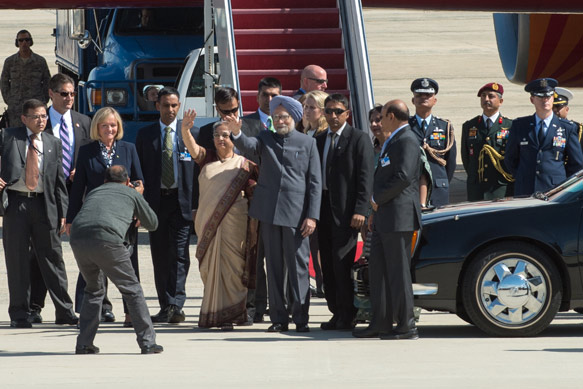Learning to agree to disagree may be the way forward.
By Sujeet Rajan
 WASHINGTON, DC: No doubt the Indian Prime minister Manmohan Singh feels special when he’s in the presence of the US President Barack Obama, but underneath the tremendous respect, civility and admiration shown by the latter to the former, an uneasy nexus of trade disputes and disagreements over the amount of globalization each country is willing to afford to the other, and grudging acknowledgment of the necessity to agree to disagree on key international issues like Pakistan, Afghanistan, Iran and Syria is likely to mar the meeting between the two leaders at the White House, tomorrow.
WASHINGTON, DC: No doubt the Indian Prime minister Manmohan Singh feels special when he’s in the presence of the US President Barack Obama, but underneath the tremendous respect, civility and admiration shown by the latter to the former, an uneasy nexus of trade disputes and disagreements over the amount of globalization each country is willing to afford to the other, and grudging acknowledgment of the necessity to agree to disagree on key international issues like Pakistan, Afghanistan, Iran and Syria is likely to mar the meeting between the two leaders at the White House, tomorrow.
Since he was feted by Obama at a fabulous state dinner at the White House in 2009, Singh and Obama have forged a close bond, with Obama often referring to Singh’s astute statesmanship. But anti-India rhetoric, from outsourcing concerns to deep cynicism by the Obama administration over what they deem as lax intellectual property rights in India – denying access to American exports by favoring indigenous products – has grown in tempo in the last four years.
India has also often hit back against the US at international forums in the recent past for what they see as anti-India policies: curbing immigration of skilled labor, hampering their IT companies, and denying Indian pharmaceutical companies’ generic medicines access to US and world markets.
However, India’s embarrassing struggle in the recent past to curb inflation, slide in the Rupee, and to maintain economic and jobs growth is also in contrast to the growing economy in the US, in the four years since the two leaders met at the White House. The power equation between the two have changed; India’s economic and currency volatility is now again at the mercy of US domestic measures on spending.
As an old adage, mostly voiced in Bollywood films, goes, ‘dosti barabar waalon main ki jaati hain.’ Unlike four years ago, when India was experiencing tremendous growth, and the US marveled at that, India is once again being viewed by the US as a country who could easily slip into economic hardship, recession, and political turbulence. India too, sees itself as once again at the cross-roads, reaching out to the US to secure business agreements, smoothen ties on a variety of fronts, but knowing fully well that the US stands to gain a lot more, especially in the defence and manufacturing sector, from doing business with her.

On the international front, Singh has the challenge to initiate diplomatic talks with Pakistan’s Prime Minister Nawaz Sharif on the sidelines of the United Nations here, on Sunday, while condemning Sharif and Pakistan in the presence of Obama tomorrow, for several acts of terrorism and transgression of its borders. Singh and Obama also might view quite the opposite on troop withdrawal from Afghanistan next year, which India fear would make it into a haven of the Taliban for attacks against her.
While India would welcome the recent announcements by Obama on Iran and Syria – with whom India has good relations with – the US do not particularly favor India doing business with Iran, however badly the country may need energy to sustain its economic growth. It remains far from clear if Obama’s recent announcement to open up a dialogue with Iran would mean that it would smile at India’s effort to get fuel from Iran. What the US may mean in diplomatic jargon on Iran is that my enemy is not your enemy, but my enemy is not your friend either.
But perhaps the nastiest piece of conversation Singh and Obama may share on Friday between strained smiles and necessary nodding of heads, may be the devastating revelation of the United states’ spying on the Indian Embassy here and the Permanent Mission in New York, as reported by The Hindu newspaper, on Thursday.
With the US reportedly using ‘bugs’ to copy entire hard drives on computers at both places, aside from other egregious spying methods that as one source said ‘left nothing to the imagination,’ Singh may feel uncomfortable every second he’s in the White House; have to remind himself there are perhaps a hundred secret surveillance cameras trained on him, as he talks with Obama. A twitch of the fingers may be up for appraisal.
Forget the White House. The Indian Prime Minister may be uncomfortable living in any place in Washington, DC, and New York, or for that matter, anywhere in the US. If the US can place ‘bugs’ at his own ‘houses’ in the two cities, at the Embassy and the Permanent Mission, which place can he trust in the US to send a confidential email or to make an important personal phone call?
It’s not known what the First Lady Michelle Obama intends to talk with the wife of Singh, Gursharan Kaur, when she hosts her for tea at the White House tomorrow. But, a different kind of strained conversation is likely to brew between their spouses once the niceties of smiling and shaking hands for photographers on the lawns is done with, and they move within for the ‘working’ part of their meeting.
To contact the author, email to sujeetrajan@americanbazaaronline.com


